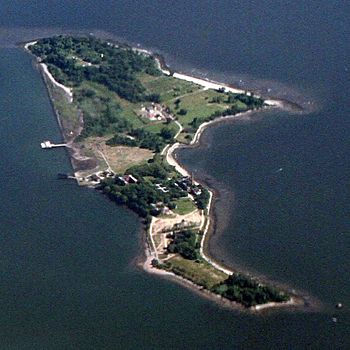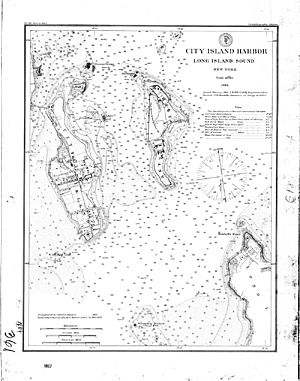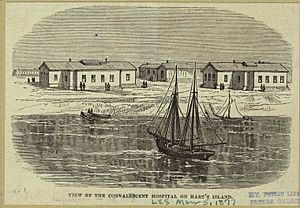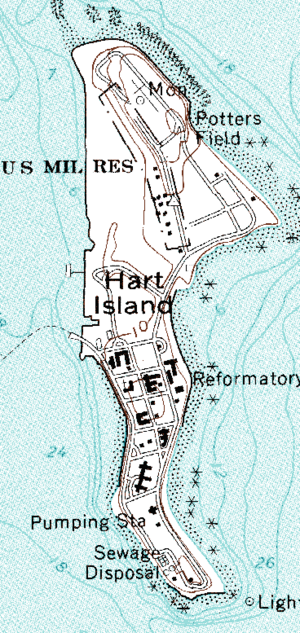Hart Island facts for kids

Aerial view of Hart Island, in 2012
|
|
| Geography | |
|---|---|
| Location | Long Island Sound |
| Coordinates | 40°51′9″N 73°46′12″W / 40.85250°N 73.77000°W |
| Archipelago | Pelham Islands |
| Area | 131.22 acres (53.10 ha) |
| Length | 1.0 mi (1.6 km) |
| Width | 0.33 mi (0.53 km) |
| State | New York |
| City | New York City |
| Borough | The Bronx |
| Additional information | |
| Time zone | |
| • Summer (DST) |
|
Hart Island is a small island in New York City. It is located at the western end of Long Island Sound. The island is about 1 mile (1.6 km) long and 0.33 miles (0.53 km) wide. It is part of the Pelham Islands group.
Over the years, Hart Island has been used for many different purposes. It was a training ground for soldiers and a prison camp. It also served as a hospital for people with mental health issues or tuberculosis. Most famously, it became a large public cemetery, also known as a "potter's field."
More than one million people are buried on Hart Island. These include people whose families could not afford a private funeral. It also includes those who were not claimed by their families. Sometimes, many people who died from diseases were buried there together.
For a long time, it was hard to visit Hart Island. The city agency that ran the island, the Department of Correction, limited who could go there. However, in 2019, the island's control moved to the New York City Department of Parks and Recreation. This change was made to make it easier for families to visit their loved ones' graves.
What's in a Name?
There are a few ideas about how Hart Island got its name. One idea is that British mapmakers called it "Heart Island" in 1775. They thought its shape looked like a heart. But the "e" was soon dropped.
Maps from 1777 and later show it as "Hart Island." Other old names for the island included "Little Minneford Island" and "Spectacle Island." "Spectacle Island" was used because its shape reminded people of eyeglasses.
Another idea comes from the word "hart," which means a male deer or stag. The island might have been named this because it was once a place for hunting deer. Or, it could be because deer used to cross from the mainland when the sound was frozen.
Island Geography
Hart Island is about 1 mile (1.6 km) long. It is about 0.33 miles (0.53 km) wide at its widest point. It sits about 0.33 miles (0.53 km) away from City Island.
The exact size of the island is sometimes debated. Some say it is 101 acres (41 ha), while others say it is 131 acres (53 ha). Hart Island is quite separate from the rest of the city. It does not have its own electricity, and the only way to get there is by ferry.
Hart Island's Story
Early Days
Before Europeans arrived, the Siwanoy tribe of Native Americans lived on Hart Island. In 1654, an English doctor named Thomas Pell bought the island. It was part of a much larger piece of land.
The island stayed in the Pell family until 1774. After that, it was sold to several other families. In the early 1800s, Hart Island became a popular spot for bare-knuckle boxing matches. Thousands of people would come to watch these fights.
A Place for Soldiers
In 1864, Hart Island was first used by the public. It became a training ground for the United States Colored Troops. A steamboat brought new soldiers to the island. They built a commander's house and barracks for the recruits. The barracks had a library and a concert room. It could hold 2,000 to 3,000 recruits at a time. Over 50,000 men were trained there.
In November 1864, a prisoner-of-war camp was built on the island. It could hold 5,000 prisoners. This camp was used for four months in 1865 during the American Civil War. It held 3,413 captured soldiers from the Confederate Army. Sadly, 235 of them died there. They were buried in Cypress Hills Cemetery. After the war, some veterans who had no money were buried on the island.
The Public Cemetery Begins
The first burials on Hart Island were 20 Union Army soldiers during the Civil War. On May 27, 1868, New York City bought the island for $75,000. City burials began soon after.
In 1869, a 24-year-old woman named Louisa Van Slyke was the first person buried in the island's public graveyard. This cemetery became known as "City Cemetery" or "Potter's Field." By 1880, the island was compared to a very expensive cemetery, but for people who were poor. Hart Island's cemetery replaced older public burial grounds in Manhattan. By 1958, over 500,000 people had been buried on the island.
Different Uses Over Time
Hart Island was used as a quarantine station during a yellow fever outbreak in 1870. During this time, the island also had a hospital for women with mental health conditions. There was also a hospital for people with tuberculosis. An industrial school for 300 students was also on the island.
In the late 1800s, a workhouse for boys was built on Hart Island. This was an extension of a prison on another island. By the early 1900s, Hart Island housed about 2,000 young people who had gotten into trouble. It also held older male prisoners. The prison on Hart Island grew and even had its own band and a chapel.
In 1924, a businessman bought land on Hart Island. He wanted to build an amusement park there. It was planned to be a place for the Black community of Harlem, as other parks did not allow them. He started building a dance hall and other attractions. However, the state government was concerned about an amusement park being so close to a jail and hospital. The city took the land back in 1925.
After World War II
During World War II, the people in prison on Hart Island were moved to Rikers Island. Hart Island's buildings were used by the military. After the war, the city reopened Hart Island as a prison.
In 1950, a homeless shelter was approved for the island. It was meant to help 2,000 people. The shelter operated from 1951 to 1954. People living on nearby City Island did not like the idea of a homeless shelter there. The city closed the shelter, and the Department of Correction took control again. In 1955, they opened a center for people dealing with alcoholism.
In 1956, missile silos were built on the island. These were part of a military defense system. They were underground and powered by large generators. These missile systems were closed in 1974.
The island continued to be used as a prison until 1966. After it closed, a drug rehabilitation center called Phoenix House opened in 1967. It grew into a community with 350 residents. Phoenix House even hosted festivals that attracted many people. In 1977, Phoenix House moved from the island.
Since then, plans to use the island for other purposes have not worked out. The city considered making it a resort in 1972, but that plan was dropped. Other ideas for shelters or workhouses also failed due to local opposition.
Abandoned Buildings and Cemetery Use
Originally, the cemetery was on the northern and southern parts of Hart Island. The middle part was used for buildings. In 1985, sixteen people who died from HIV/AIDS were buried in a remote part of the island. At the time, there were fears that their remains might be contagious. The first child to die of AIDS in New York City is buried in the only single grave with a concrete marker. It reads "SC B1 1985."
Many old wooden and stone buildings on the island have fallen apart. Military barracks from the Civil War era were used before hospitals and workhouses were built. In the late 2010s, groups started asking for Hart Island to be listed as a historic place. In 2016, the island was called a "site of historical significance."
Hurricane Sandy in 2012 caused a lot of damage to the island. Some of the shoreline washed away, revealing buried skeletons. The city announced plans to fix the shoreline. The federal government gave $13.2 million for this project in 2015. Work on the shoreline began in September 2019.
In December 2019, control of the island moved to the New York City Department of Parks and Recreation. Burials in the public cemetery continued, but now city workers handle them. In 2021, the city decided to tear down eighteen severely damaged buildings on the island.
The Public Cemetery
Hart Island is home to New York City's 131-acre (53 ha) public cemetery, or "potter's field." It is often called the largest tax-funded cemetery in the United States. It is also one of the largest mass graves in the country. At least 850,000 people have been buried there. Since the 2000s, fewer than 1,500 burials happen each year.
About one-third of the annual burials are infants and stillborn babies. This number has gone down since 1997, when a health program began covering all pregnant women in New York State. Today, people from many different backgrounds are buried on the island. In 2022, it was noted that recent burials included a ballet dancer, a nurse, and a software engineer.
Burials During Disease Outbreaks
Hart Island has also been used for burials during epidemics and pandemics. During the 1980s AIDS epidemic, people who died from AIDS were first buried in separate graves. Later, it was found that the virus could not spread from bodies. So, people who died of AIDS were then buried in the mass graves.
In 2008, the island was chosen as a site for mass burials if a very bad flu pandemic happened. It could hold up to 20,000 bodies. During the COVID-19 pandemic in New York City, Hart Island was used for temporary burials. This was for people who died from COVID-19 if other places became too full. In April 2020, burials increased sharply. The number of burials went from 846 in 2019 to 2,334 in 2020.
Burial Records
Many old burial records were destroyed in a fire in 1977. Records from before 1977 are kept in the city's archives. Records after that date are now put into a digital database. Some of this information is available online. In 2008, a group called the Hart Island Project was given access to 50,000 burial records.
Famous People Buried Here
Not everyone buried on Hart Island was homeless or poor. Many people buried there had families who could not afford private funerals. Or, their relatives did not claim their bodies within a month of their death.
Some notable people buried on Hart Island include:
- Leo Birinski: A playwright and film writer, buried in 1951.
- Mihri Müşfik Hanım: A painter, buried in 1954.
- Dawn Powell: An American novelist, buried in 1970. Her remains were used for medical studies first.
- Bobby Driscoll: An Academy Award-winning actor, buried in 1968. His body could not be identified quickly.
- T-Bone Slim: A labor activist and songwriter, buried after his body was found in the Hudson River.
Public Involvement
The Hart Island Project
The Hart Island Project is a non-profit group started by artist Melinda Hunt in 1994. This group works to make it easier for people to visit the island. They also help families get burial records. The organization has a website to help people find relatives buried on the island.
Since 2009, the city has given burial records to the Hart Island Project. The group keeps an online database of burials from 1980 onward. The project has helped make changes to how people can access Hart Island. For example, the island is now open monthly for visits. Also, the Department of Correction must publish burial records online.
The Hart Island Project has used GPS to map the grave trenches. In 2014, they launched an interactive map called the "Traveling Cloud Museum." This map lets people share stories, photos, and videos about those buried on the island. The map was updated in 2018 to include drone images. It shows nearly 69,000 burials.
New Laws for Access
On October 28, 2011, the New York City Council held a meeting about how the public cemetery on Hart Island was run. A law passed in 2013 required the Department of Correction to put burial records and visitation rules online. In April 2013, they published an online database with 66,000 entries from 1977 onward.
Transfer to Parks Department
A bill was introduced in 2012 to move control of the island to the New York City Department of Parks and Recreation. The Hart Island Project supported this bill, but it did not pass at first.
The bill was brought up again in 2014 and 2018. Supporters wanted families to be able to visit graves more easily. In November 2019, the New York City Council voted to transfer control to the Parks Department. Mayor Bill de Blasio signed the law the next month. NYC Parks officially took full control of the island in July 2021.
Visiting Hart Island
The only way to reach Hart Island is by ferryboat. Hart Island and the ferry pier on City Island are restricted areas. Families who want to visit the island must ask the Department of Correction ahead of time. The city allows family members to visit and leave mementos at grave sites. They have an online and phone system to schedule these visits. Other members of the public can visit by appointment too.
Ferry Service
The city used to have a ferry service that ran often between City and Hart islands. The ferries also carried bodies. By the 1960s, two ferryboats were used. This service was very expensive to run. By 1977, the city had fewer ferry trips.
Under the new law from 2019, the New York City Department of Transportation is supposed to run the ferry service more often.
Easier Access
Visiting the island has become easier thanks to groups like the Hart Island Project. The Department of Correction used to be against making access easier.
In July 2015, the Department of Correction started a new policy. Up to five family members and their guests could visit grave sites once a month on a weekend. The first visit under this new rule happened on July 19, 2015. Visits to individual graves happen twice a month. Visits to the island's gazebo, for the general public, happen once a month. The ferry leaves from a restricted dock on City Island. In 2017, the city increased the number of visitors allowed each month.
During the COVID-19 pandemic, public visits were stopped. They started again in May 2021, but with fewer visitors allowed per trip. Even after NYC Parks took over, there was little change for visitors in October 2021. NYC Parks is now looking into ways to improve access, like shuttle buses or new ferry routes.
|
See also
 In Spanish: Isla Hart para niños
In Spanish: Isla Hart para niños






